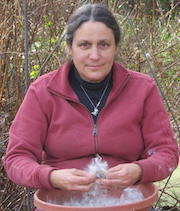Esther McEvoy
Last Updated on March 23, 2024 by Tom Pratum

Esther Helen Gruber McEvoy earned a BA in Art from Lewis and Clark College in 1974 and a BS from Portland State University (PSU) in 1978. During the late 1970s she worked as a teaching assistant in two locations: a botany class at PSU and field botany and soil invertebrate classes at the Malheur Field Station. While at PSU she served as a lab technician for the Oregon Department of Environmental Quality for four years on a project monitoring the effects of DDT on soil invertebrate in northeastern Oregon.
During the field seasons of 1979 and 1980 she worked as a range conservationist (actually botanist) for the Burns District of the Bureau of Land Management (BLM) conducting rare plant inventories at Diamond Craters, a special management area of recent volcanic activity. Her work helped with the establishment of Diamond Craters as an Outstanding Natural Area. In 1979, Esther (along with fellow student scientists at OSU) obtained a National Science Foundation grant to study the ecology of the Alvord Dunes, which lie south of Steens Mountain. Esther collected soil invertebrate samples from the desert shrub communities and analyzed them at OSU in Corvallis during the fall and winter months. It was during this time that she met her future husband, Peter McEvoy, in the Entomology Department at OSU. During the field season of 1981, Esther worked for the Willamette National Forest searching for old growth in the Coast Range with John Christy.
Esther, along with fellow botanists at OSU, founded the Corvallis Chapter of NPSO in 1981. Starting in the spring of 1983 she worked as a field assistant for two field seasons on a research project to burn and re-vegetate the native wet prairie at William L. Finley National Wildlife Refuge with Dr. Bob Frenkel, OSU. They found that some of the shrubs invading the prairie thrived on burns, especially the roses. Starting in 1985, as NPSO Legislative Committee Chair, she spent two years writing a draft of the State Endangered Species Bill, which was passed in 1987, the culmination of years of hard work by many environmental groups. The Act directed the Oregon Department of Agriculture to monitor and protect the State’s threatened and endangered plants. Over the last twenty years Esther has led many NPSO field trips with Phil Hays and Bob Frenkel to Marys Peak, the highest point in the Oregon Coast Range. The three friends published an article on the Marys Peak Scenic Botanical Area in Kalmiopsis in 2012 (19:21-35).
In 2000 Esther started Willamette Gardens, a native plant nursery that specializes in organically grown native plants from Oregon and neighboring states. Esther donates plant material and time to support the Corvallis Chapter. She recently assisted Benton County to become the first county certified as a National Wildlife Federation backyard habitat area. In addition to her busy life as a small business owner and conservation activist, she and her husband have raised two children, a son and a daughter. She is currently (2015) vice-president of Corvallis Chapter and helps maintain the native plant garden surrounding the Avery House Nature Center at the Corvallis Environmental Center. — Rana Foster, Corvallis Chapter.
